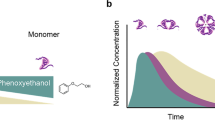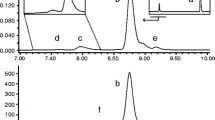Abstract
Hydrolysis of insulin has been studied during storage of various preparations at different temperatures. Insulin deteriorates rapidly in acid solutions due to extensive deamidation at residue AsnA21. In neutral formulations deamidation takes place at residue AsnB3 at a substantially reduced rate under formation of a mixture of isoAsp and Asp derivatives. The rate of hydrolysis at B3 is independent of the strength of the preparation, and in most cases the species of insulin, but varies with storage temperature and formulation. Total transformation at B3 is considerably reduced when insulin is in the crystalline as compared to the amorphous or soluble state, indicating that formation of the rate-limiting cyclic imide decreases when the flexibility of the tertiary structure is reduced. Neutral solutions containing phenol showed reduced deamidation probably because of a stabilizing effect of phenol on the tertiary structure (α-helix formation) around the deamidating residue, resulting in a reduced probability for formation of the intermediate imide. The ratio of isoAsp/Asp derivative was independent of time and temperature, suggesting a pathway involving only intermediate imide formation, without any direct side-chain hydrolysis. However, increasing formation of Asp relative to isoAsp derivative was observed with decreasing flexibility of the insulin three-dimensional structure in the formulation. In certain crystalline suspensions a cleavage of the peptide bond A8–A9 was observed. Formation of this split product is species dependent: bovine > porcine > human insulin. The hydrolytic cleavage of the peptide backbone takes place only in preparations containing rhombohedral crystals in addition to free zinc ions.
Similar content being viewed by others
REFERENCES
W. O. Storvick and H. J. Henry. Effect of storage temperature on stability of commercial insulin preparations. Diabetes 17:499–502 (1968).
M. Pingel and A. Vølund. Stability of insulin preparations. Diabetes 21:805–813 (1972).
F. Sundby. Separation and characterization of acid-induced insulin transformation products by paper electrophoresis in 7 M urea. J. Biol. Chem. 237:3406–3411 (1962).
L. I. Slobin and F. H. Carpenter. The labile amide in insulin: Preparation of desalanine-desamido-insulin. Biochemistry 2:22–28 (1963).
B. V. Fisher and P. B. Porter. Stability of bovine insulin. J. Pharm. Pharmacol. 33:203–206 (1981).
R. L. Jackson, W. O. Storvick, C. S. Hollinden, L. E. Stroeh, and J. G. Stilz. Neutral regular insulin. Diabetes 21:235–245 (1972).
J. Schlichtkrull, M. Pingel, L. G. Heding, J. Brange, and K. H. Jørgensen. Insulin preparations with prolonged effect. In A. Hasselblatt and F. von Bruchhausen (eds.), Handbook of Experimental Pharmacology, New Series, Vol. XXXII/2, Springer-Verlag, Berlin, Heidelberg, New York, 1975, pp. 729–777.
J. Brange, B. Skelbaek-Pedersen, L. Langkjaer, U. Damgaard, H. Ege, S. Havelund, L. G. Heding, K. H. Jørgensen, J. Lykkeberg, J. Markussen, M. Pingel, and E. Rasmussen. Galenics of Insulin: The Physico-chemical and Pharmaceutical Aspects of Insulin and Insulin Preparations, Springer-Verlag, Berlin, Heidelberg, New York, London, Paris, Tokyo, 1987.
J. Schlichtkrull, J. Brange, A. H. Christiansen, O. Hallund, L. G. Heding, K. H. Jørgensen, S. M. Rasmussen, E. Sørensen, and A. Vølund. Monocomponent insulin and its clinical implications. Horm. Metab. Res. (Suppl. Ser.) 5:134–143 (1974).
J. Brange, S. Havelund, and P. Hougaard. Chemical stability of insulin. 2. Formation of higher molecular weight transformation products during storage of pharmaceutical preparations. Pharm. Res. 9:727–734 (1992).
M. C. Manning, K. Patel, and R. T. Borchardt. Stability of protein Pharmaceuticals. Pharm. Res. 6:903–918 (1989).
A. B. Robinson and C. J. Rudd. Deamidation of glutaminyl and asparaginyl residues in peptides and proteins. Current Topics in Cellular Regulation, Vol. 8, Academic Press, New York, 1974, pp. 247–295.
T. Geiger and S. Clarke. Deamidation, isomerization, and racemization at asparaginyl and aspartyl residues in peptides. Succinimide-linked reactions that contribute to protein degradation. J. Biol. Chem. 262:785–794 (1987).
J. Brange, L. Langkjær, S. Havelund, and E. Sørensen. Chemical stability of insulin: Neutral insulin solutions. Diabetologia 25:193 (1983) (abstr).
J. Brange, L. Langkjær, S. Havelund, and E. Sørensen. Chemical stability of insulin: Formation of desamidido insulins and other hydrolytic products in intermediate-and long-acting insulin preparations. Diabetes Res. Clin. Pract. Suppl. 1:67 (1985) (abstr).
J. Brange, S. Havelund, E. Hommel, E. Sørensen, and C. Kühl. Neutral insulin solutions physically stabilized by addition of Zn2+. Diabet. Med. 3:532–536 (1986).
R. Lura and V. Schirch. Role of peptide conformation in the rate and mechanism of deamidation of asparaginyl residues. Biochemistry 21:7671–7677 (1988).
S. J. Leach and H. Lindley. The kinetics of hydrolysis of the amide group in proteins and peptides. Part 2. Acid hydrolysis of glycyl-and l-leucyl-l-asparagine. Trans. Faraday Soc. 49:921–925 (1953).
H. T. Wright. Sequence and structure determinants of the nonenzymatic deamidation of asparagin and glutamine residues in proteins. Protein Eng. 4:283–294 (1991).
P. Bornstein and G. Balian. Cleavage at Asn-Gly bonds with hydroxylamine. Methods Enzymol. 47:132–145 (1977).
Y. C. Meinwald, E. R. Stimson, and H. A. Scheraga. Deamidation of the asparaginyl-glycyl sequence. Int. J. Peptide Protein Res. 28:79–84 (1986).
R. C. Stephenson and S. Clarke. Succinimide formation from aspartyl and asparaginyl peptides as a model for the spontaneous degradation of proteins. J. Biol. Chem. 264:6164–6170 (1989).
S. Clarke. Propensity for spontaneous succinimide formation from aspartyl and asparaginyl residues in cellular proteins. Int. J. Peptide Protein Res. 30:808–821 (1987).
C. E. M. Voorter, W. A. de Haard-Hoekman, P. J. M. van den Oetelaar, H. Bloemendal, and W. W. de Jong. Spontaneous peptide bond cleavage in aging α-crystallin through a succinimide intermediate. J. Biol. Chem. 263:19020–19023 (1988).
N. P. Bhatt, K. Patel, and R. T. Borchardt. Chemical pathways of peptide degradation. I. Deamidation of adrenocorticotropic hormone. Pharm. Res. 7:593–599 (1990).
A. A. Kossiakoff. Tertiary structure is a principal determinant to protein deamidation. Science 240:191–194 (1988).
A. Wollmer, B. Rannefeld, B. R. Johansen, K. R. Hejnaes, P. Balschmidt, and F. B. Hansen. Phenol-promoted structural transformation of insulin in solution. Biol. Chem. Hoppe-Seyler 368:903–911 (1987).
U. Derewenda, Z. Derewenda, E. J. Dodson, G. G. Dodson, C. D. Reynolds, G. D. Smith, C. Sparks, and D. Swenson. Phenol stabilizes more helix in a new symmetrical zinc insulin hexamer. Nature 338:594–596 (1989).
R. Gregory, S. Edwards, and N. A. Yateman. Demonstration of insulin transformation products in insulin vials by high-performance liquid chromatography. Diabetes Care 14:42–48 (1991).
E. N. Baker, T. L. Blundell, J. F. Cutfield, S. M. Cutfield, E. J. Dodson, G. G. Dodson, D. M. C. Hodgkin, R. E. Hubbard, N. W. Isaacs, C. D. Reynolds, K. Sakabe, N. Sakabe, and N. M. Vijayan. The structure of 2Zn pig insulin crystals at 1.5 Å resolution. Phil. Trans. R. Soc. 319:369–456 (1988).
S. Toma, S. Campagnoli, E. De Gregoriis, R. Gianna, I. Margarit, M. Zamai, and G. Grandi. Effect of Glu-143 and His-231 substitutions on the catalytic activity and secretion of bacillus subtilis neutral protease. Protein Eng. 2:359–364 (1989).
W. G. Reeves. Immunogenicity of insulin of various origins. Neth. J. Med. 28 (Suppl 1):43–46 (1985).
S. Fankhauser. Neuere Aspekte der Insulintherapie. Schweiz Med. Wochenschr. 99:414–420 (1969).
N. S. Fineberg, S. E. Fineberg, R. J. Mahler, and L. G. Linarelli. Is regular human insulin less immunogenic than repository? Diabetes 35 (Suppl 1):91A (1986) (abstr).
D. C Robbins, S. M. Cooper, S. E. Fineberg, and P. M. Mead. Antibodies to covalent aggregates of insulin in blood of insulinusing diabetic patients. Diabetes 36:838–841 (1987).
Author information
Authors and Affiliations
Additional information
To whom correspondence should be addressed at Nove Research Institute, Novo Alle, DK-2880Bagsvaerd, Denmark
Rights and permissions
About this article
Cite this article
Brange, J., Langkj\sgmaelig;r, L., Havelund, S. et al. Chemical Stability of Insulin. 1. Hydrolytic Degradation During Storage of Pharmaceutical Preparations. Pharm Res 9, 715–726 (1992). https://doi.org/10.1023/A:1015835017916
Issue Date:
DOI: https://doi.org/10.1023/A:1015835017916




